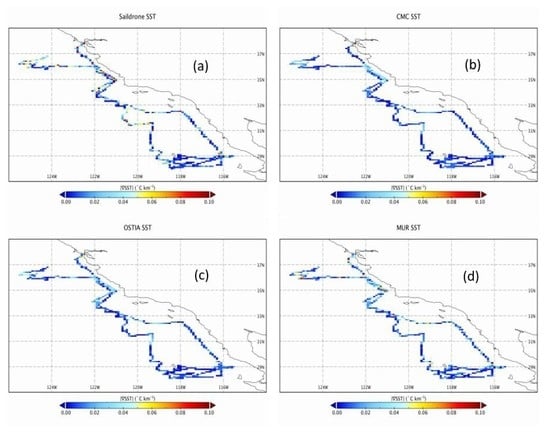Comparison of Satellite-Derived Sea Surface Temperature and Sea Surface Salinity Gradients Using the Saildrone California/Baja and North Atlantic Gulf Stream Deployments
Abstract
1. Introduction
2. Methodology and Data
- (1)
- the Canadian Meteorological Office CMC;
- (2)
- the Naval Oceanographic Office NAVO K10;
- (3)
- the Remote Sensing Systems REMSS_MW_IR;
- (4)
- the UK Meteorological Office OSTIA;
- (5)
- the Danish Meteorological Institute DMI; and
- (6)
- the Jet Propulsion Laboratory MUR.
- (1)
- the Jet propulsion Laboratory version 4.0 Soil Moisture Active Passive (SMAP) (JPLSMAP); and
- (2)
- the Remote Sensing Systems version 4.0, 40 km (RSS40) dataset.
3. Results
3.1. California Current Upwelling System (CCUS)
3.2. North Atlantic Gulf Stream (NAGS)
4. Conclusions
Supplementary Materials
Supplementary File 1Author Contributions
Funding
Acknowledgments
Conflicts of Interest
References
- Vazquez-Cuervo, J.; Gomez-Valdes, J.; Bouali, M.; Miranda, L.E.; Van Der Stocken, T.; Tang, W.; Gentemann, C. Using Saildrones to Validate Satellite-Derived Sea Surface Salinity and Sea Surface Temperature along the California/Baja Coast. Remote Sens. 2019, 11, 1964. [Google Scholar] [CrossRef]
- Meissner, T.; Wentz, F.J.; Le Vine, D.M. The Salinity Retrieval Algorithms for the NASA Aquarius Version 5 and SMAP Version 3 Releases. Remote Sens. 2018, 10, 1121. [Google Scholar] [CrossRef]
- Gentemann, C.L.; Scott, J.P.; Mazzini, P.L.; Pianca, C.; Akella, S.; Minnett, P.J.; Cornillon, P.; Fox-Kemper, B.; Cetinić, I.; Chin, T.M.; et al. Saildrone: Adaptively sampling the marine environment. Bull. Am. Meteorol. Soc. 2020. [Google Scholar] [CrossRef]
- Yang, H.; Gao, Q.; Ji, H.; He, P.; Zhu, T. Sea surface temperature data from coastal observation stations: Quality control and semidiurnal characteristics. Acta Oceanol. Sin. 2019, 38, 31–39. [Google Scholar] [CrossRef]
- Hou, A.; Bahr, A.; Schmidt, S.; Strebl, C.; Albuquerque, A.L.; Chiessi, C.M.; Friedrich, O. Forcing of western tropical South Atlantic sea surface temperature across three glacial-interglacial cycles. Glob. Planet. Chang. 2020, 188, 103150. [Google Scholar] [CrossRef]
- Chelton, D.B.; Schlax, M.G.; Freilich, M.H.; Milliff, R.F. Satellite Measurements Reveal Persistent Small-Scale Features in Ocean Winds. Science 2004, 303, 978–983. [Google Scholar] [CrossRef] [PubMed]
- Castelao, R.M.; Barth, J.A. Upwelling around Cabo Frio, Brazil: The importance of wind stress curl. Geophys. Res. Lett. 2006, 33, 33. [Google Scholar] [CrossRef]
- Chelton, D.B.; Schlax, M.G.; Samelson, R.M. Summertime Coupling between Sea Surface Temperature and Wind Stress in the California Current System. J. Phys. Oceanogr. 2007, 37, 495–517. [Google Scholar] [CrossRef]
- Bouali, M.; Polito, P.S.; Sato, O.T.; Vazquez-Cuervo, J. On the use of NLSST and MCSST for the study of spatio-temporal trends in SST gradients. Remote Sens. Lett. 2019, 10, 1163–1171. [Google Scholar] [CrossRef]
- Dufois, F.; Penven, P.; Whittle, C.P.; Veitch, J. On the warm nearshore bias in Pathfinder monthly SST products over Eastern Boundary Upwelling Systems. Ocean Model. 2012, 47, 113–118. [Google Scholar] [CrossRef]
- Meneghesso, C.; Seabra, R.; Broitman, B.R.; Wethey, D.S.; Burrows, M.T.; Chan, B.K.K.; Guy-Haim, T.; Ribeiro, P.A.; Rilov, G.; Santos, A.M.; et al. Remotely-sensed L4 SST underestimates the thermal fingerprint of coastal upwelling. Remote Sens. Environ. 2020, 237, 111588. [Google Scholar] [CrossRef]
- Pereira, F.; Bouali, M.; Polito, P.S.; Silveira, I.C.A.d.; Candella, R.N. Discrepancies between satellite-derived and in situ SST data in the Cape Frio Upwelling System, Southeastern Brazil (23°S). Remote Sens. Lett. 2020, 11, 555–562. [Google Scholar] [CrossRef]
- Bouali, M.; Sato, O.T.; Polito, P.S. Temporal trends in sea surface temperature gradients in the South Atlantic Ocean. Remote Sens. Environ. 2017, 194, 100–114. [Google Scholar] [CrossRef]
- Peres, L.; Franca, G.B.; Paes, R.C.O.V.; Sousa, R.C.; Oliveira, A.N. Analyses of the Positive Bias of Remotely Sensed SST Retrievals in the Coastal Waters of Rio de Janeiro. IEEE Trans. Geosci. Remote Sens. 2017, 55, 6344–6353. [Google Scholar] [CrossRef]
- Pimentel, G.R.; Franca, G.B.; Peres, L.F. Removal of the MCSST MODIS SST Bias during Upwelling Events along the Southeastern Coast of Brazil. IEEE Trans. Geosci. Remote Sens. 2019, 57, 3566–3573. [Google Scholar] [CrossRef]
- Chang, Y.; Cornillon, P. A comparison of satellite-derived sea surface temperature fronts using two edge detection algorithms. Deep. Sea Res. Part Top. Stud. Oceanogr. 2015, 119, 40–47. [Google Scholar] [CrossRef]
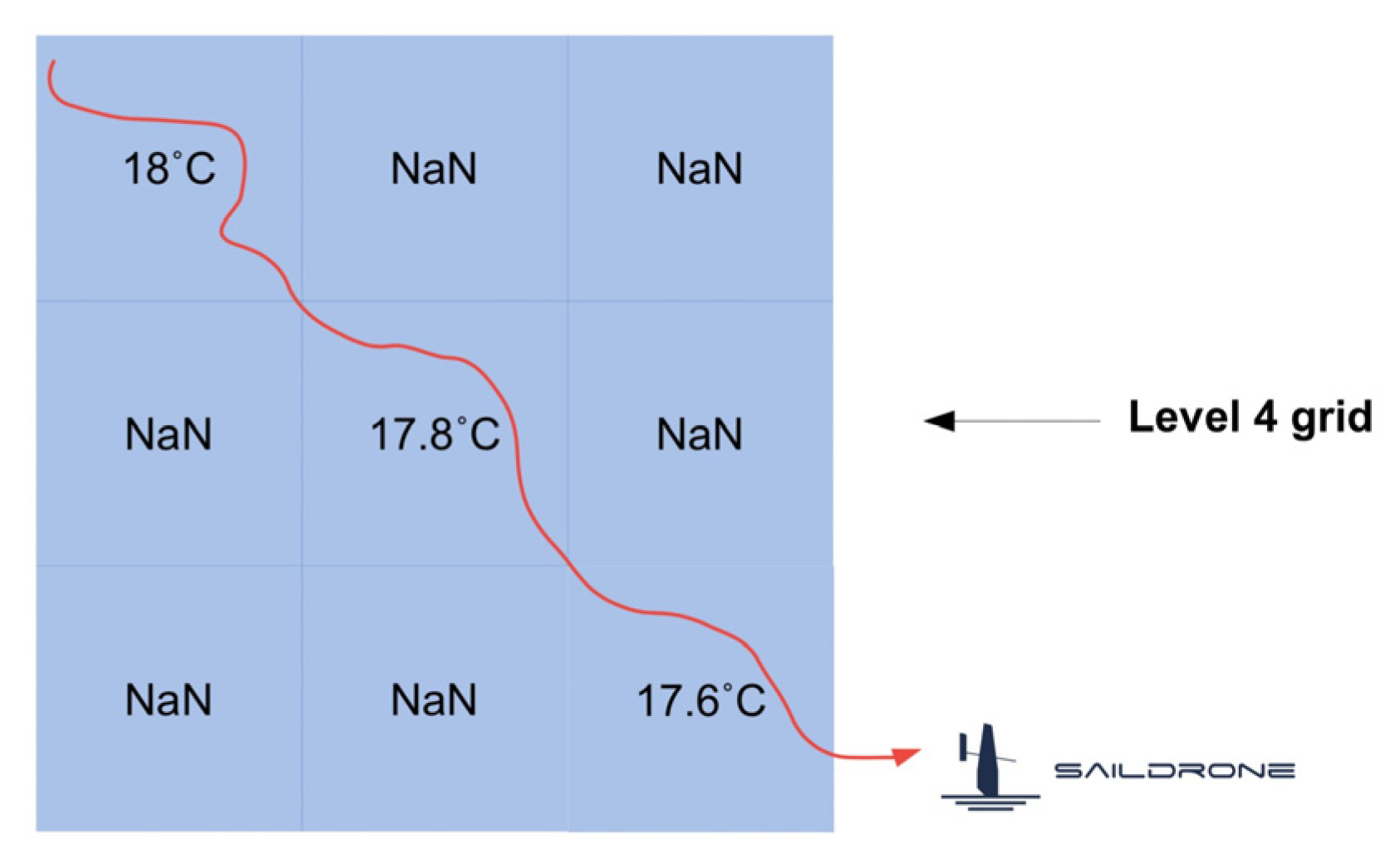
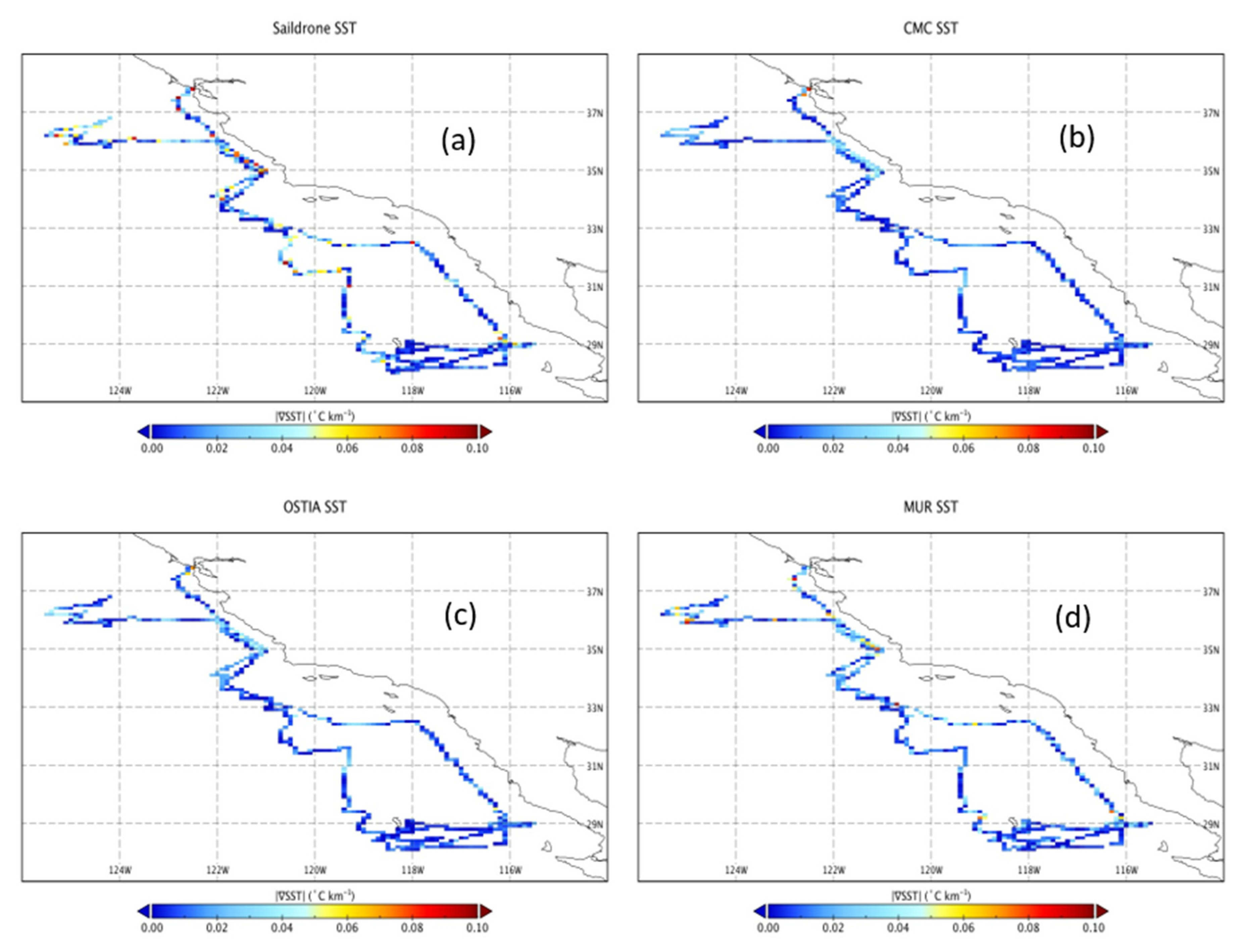
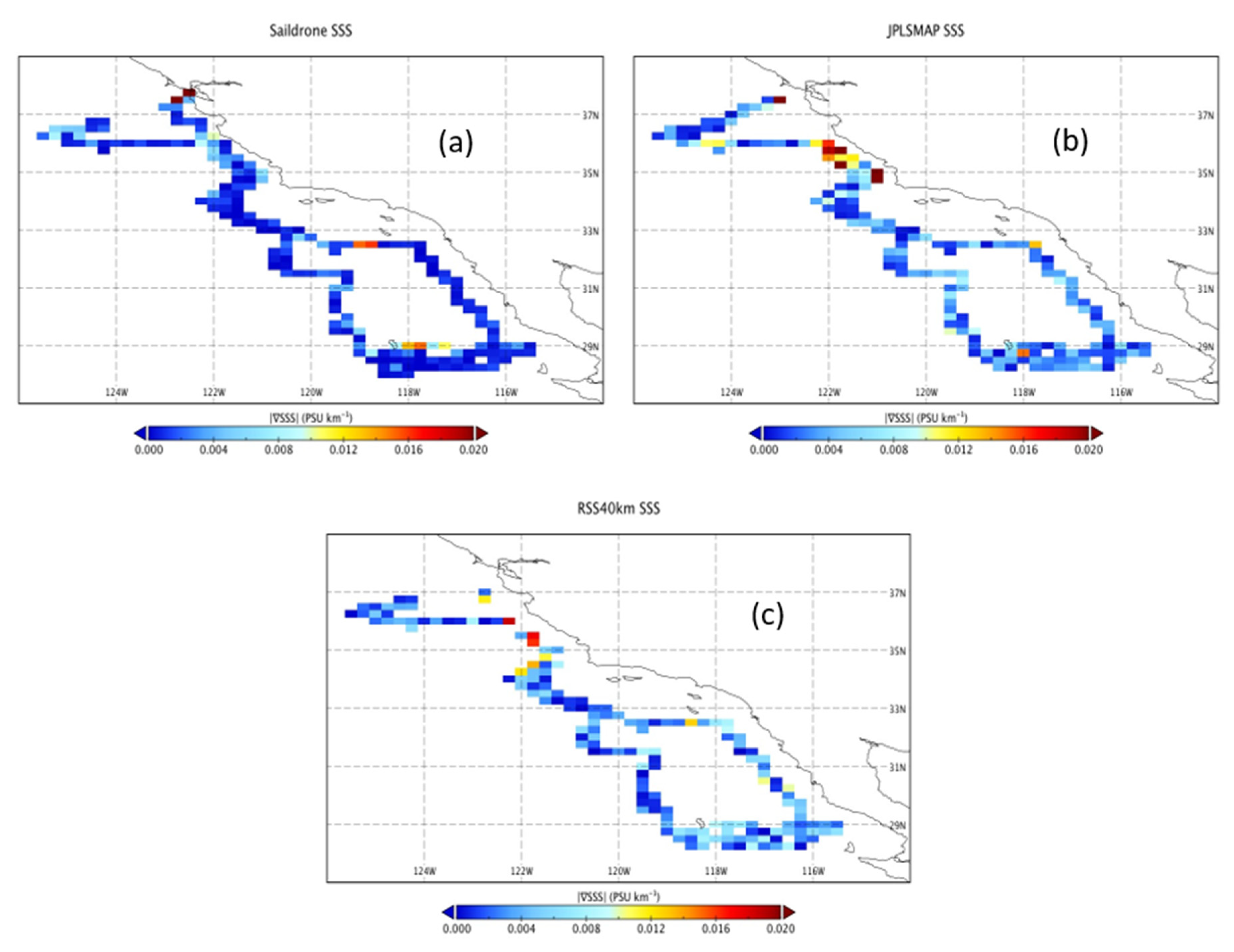

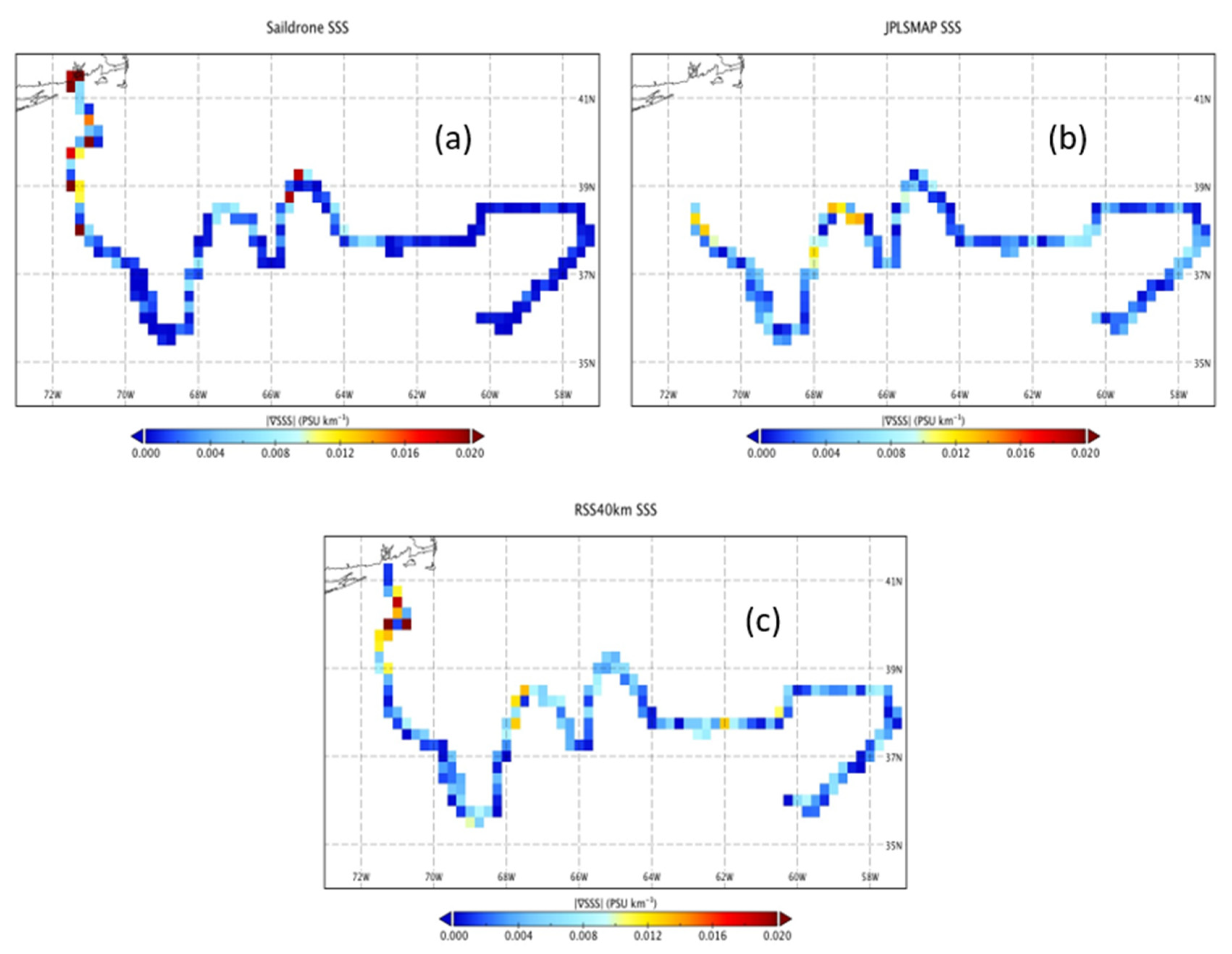
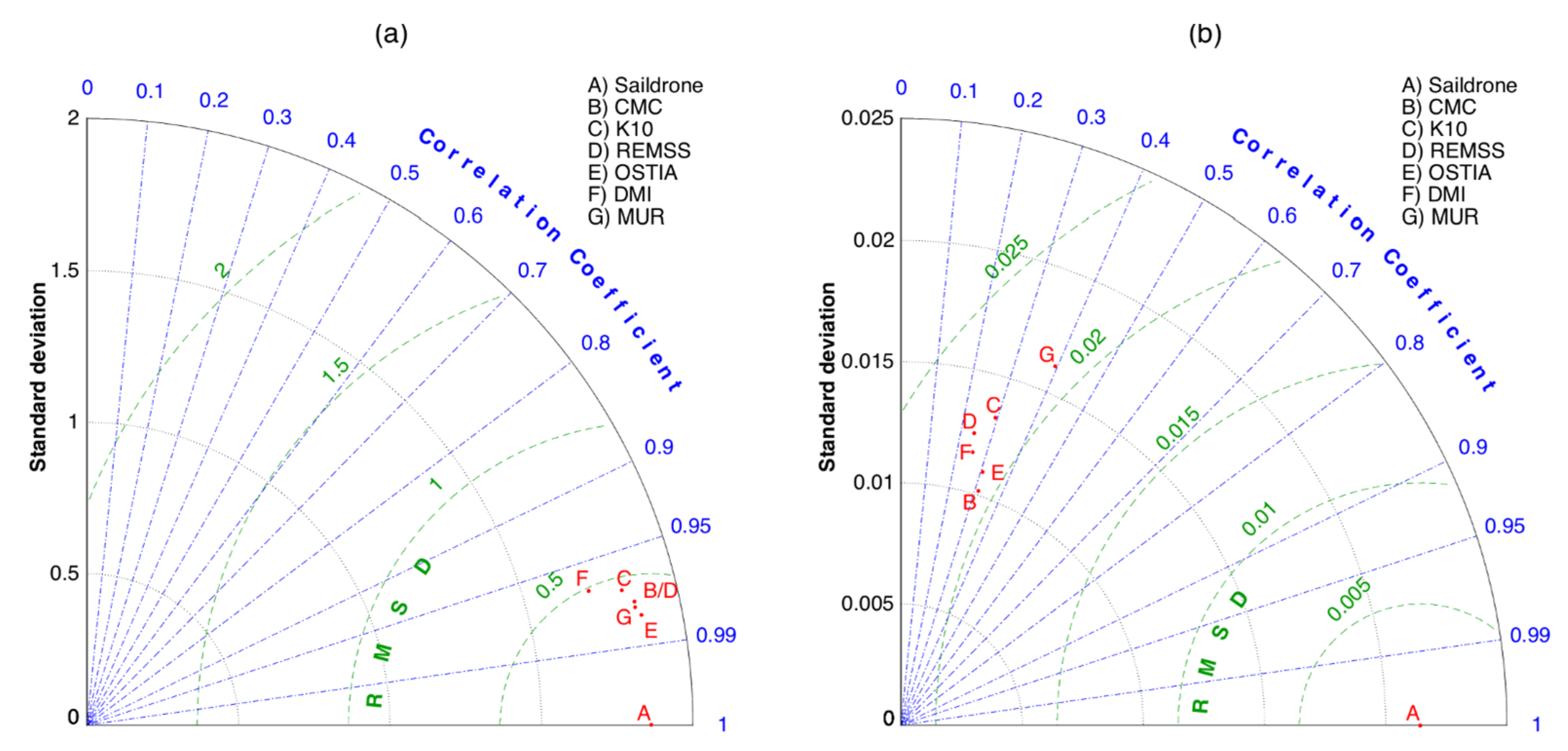
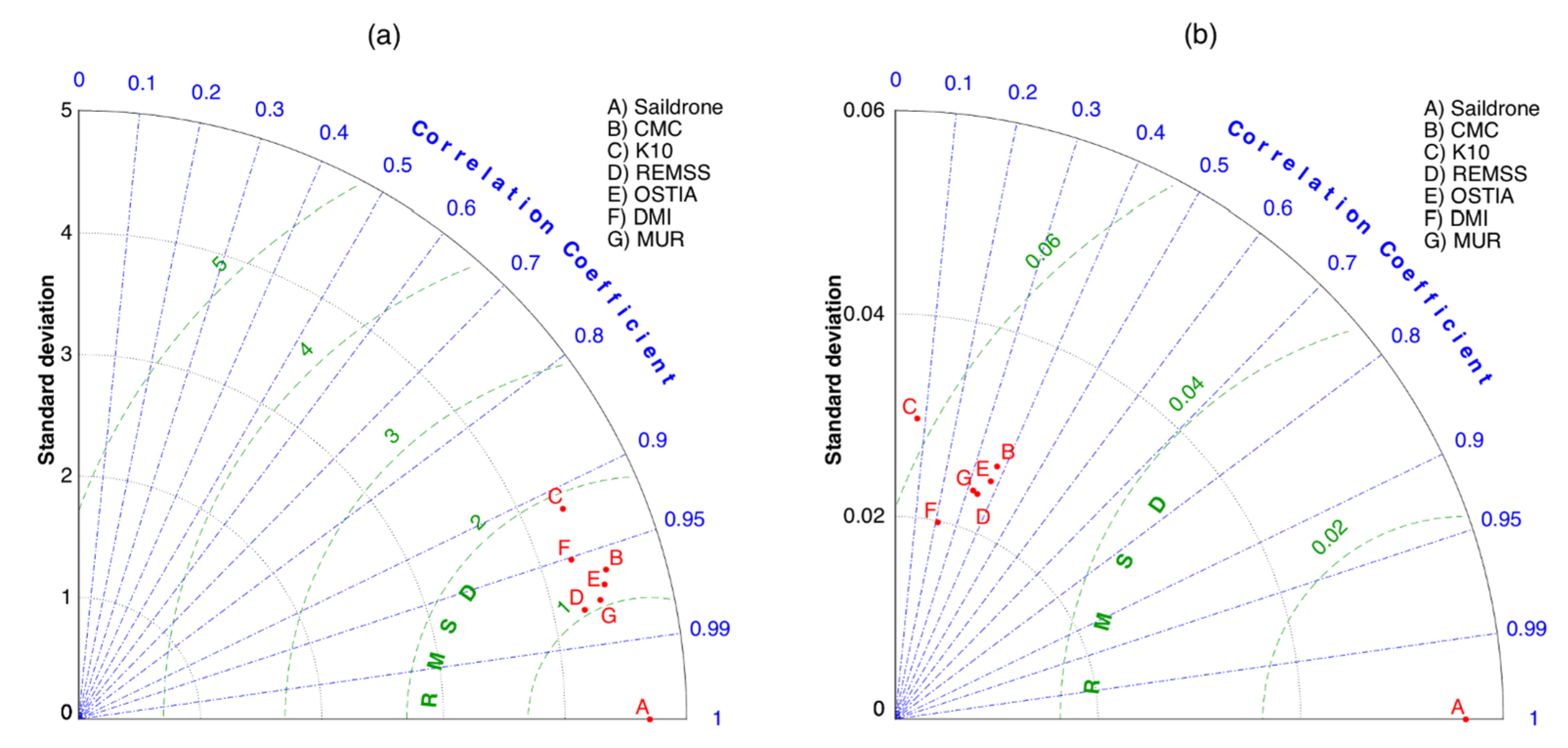
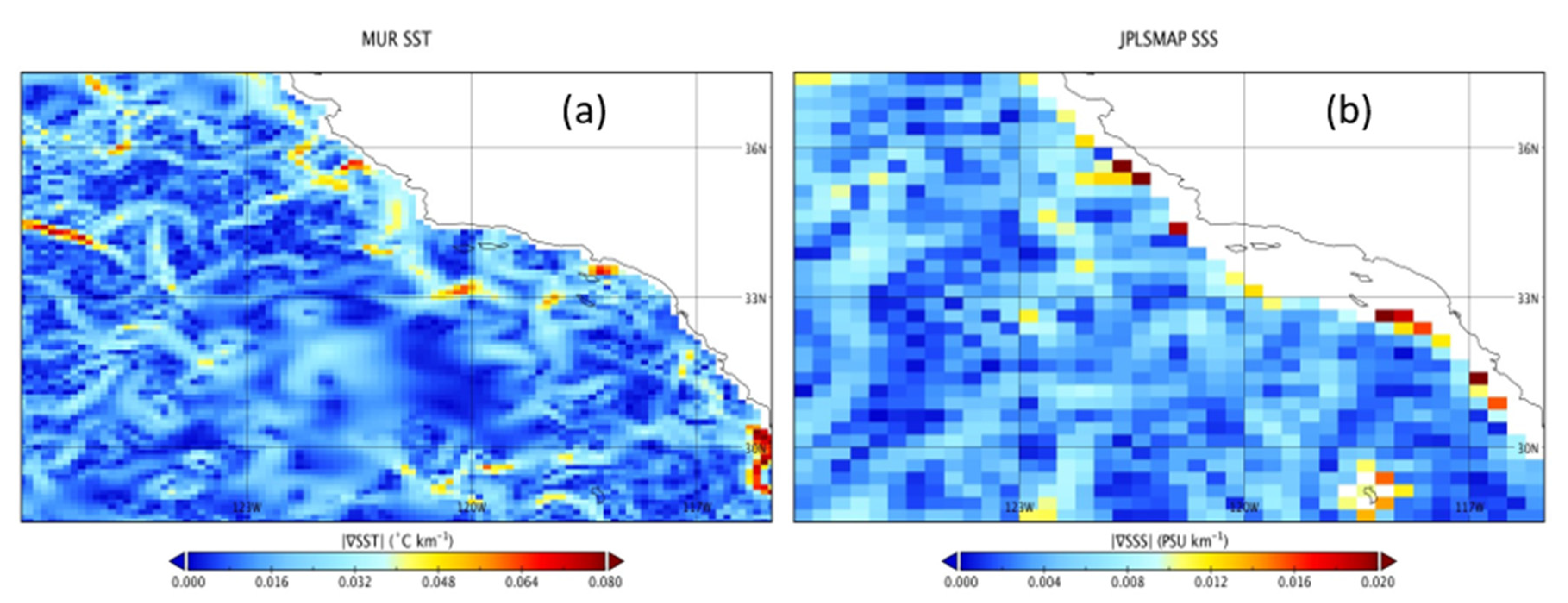
| Data Set | Parameter | Bias | RMSD | Correlation |
|---|---|---|---|---|
| CMC | SST | −0.074 | 0.417 | 0.975 |
| |∇SST| | −0.009 | 0.022 | 0.315 | |
| K10 | SST | 0.137 | 0.475 | 0.969 |
| |∇SST| | −0.007 | 0.022 | 0.293 | |
| REMSS | SST | 0.075 | 0.401 | 0.977 |
| |∇SST| | −0.007 | 0.023 | 0.243 | |
| OSTIA | SST | 0.022 | 0.365 | 0.980 |
| |∇SST| | −0.008 | 0.022 | 0.306 | |
| DMI | SST | 0.040 | 0.489 | 0.966 |
| |∇SST| | −0.008 | 0.023 | 0.255 | |
| MUR | SST | 0.285 | 0.500 | 0.975 |
| |∇SST| | −0.003 | 0.021 | 0.395 | |
| JPLSMAP | SSS | 0.141 | 0.414 | 0.429 |
| |∇SSS| | 0.002 | 0.005 | 0.128 | |
| RSSV4 | SSS | −0.170 | 0.336 | 0.464 |
| |∇SSS| | 0.002 | 0.004 | 0.072 |
| Data Set | Parameter | Bias | RMSD | Correlation |
|---|---|---|---|---|
| CMC | SST | −0.350 | 1.310 | 0.962 |
| |∇SST| | −0.012 | 0.054 | 0.374 | |
| K10 | SST | −0.688 | 1.928 | 0.917 |
| |∇SST| | −0.009 | 0.062 | 0.072 | |
| REMSS | SST | −0.085 | 0.962 | 0.977 |
| |∇SST| | −0.016 | 0.055 | 0.342 | |
| OSTIA | SST | −0.209 | 1.185 | 0.968 |
| |∇SST| | −0.012 | 0.053 | 0.371 | |
| DMI | SST | 0.002 | 1.401 | 0.951 |
| |∇SST| | −0.017 | 0.058 | 0.210 | |
| MUR | SST | −0.051 | 1.057 | 0.975 |
| |∇SST| | −0.010 | 0.054 | 0.321 | |
| JPLSMAP | SSS | −0.325 | 0.437 | 0.591 |
| |∇SSS| | 0.001 | 0.006 | 0.084 | |
| RSSV4 | SSS | −0.151 | 0.457 | 0.932 |
| |∇SSS| | 0.001 | 0.007 | 0.140 |
© 2020 by the authors. Licensee MDPI, Basel, Switzerland. This article is an open access article distributed under the terms and conditions of the Creative Commons Attribution (CC BY) license (http://creativecommons.org/licenses/by/4.0/).
Share and Cite
Vazquez-Cuervo, J.; Gomez-Valdes, J.; Bouali, M. Comparison of Satellite-Derived Sea Surface Temperature and Sea Surface Salinity Gradients Using the Saildrone California/Baja and North Atlantic Gulf Stream Deployments. Remote Sens. 2020, 12, 1839. https://doi.org/10.3390/rs12111839
Vazquez-Cuervo J, Gomez-Valdes J, Bouali M. Comparison of Satellite-Derived Sea Surface Temperature and Sea Surface Salinity Gradients Using the Saildrone California/Baja and North Atlantic Gulf Stream Deployments. Remote Sensing. 2020; 12(11):1839. https://doi.org/10.3390/rs12111839
Chicago/Turabian StyleVazquez-Cuervo, Jorge, Jose Gomez-Valdes, and Marouan Bouali. 2020. "Comparison of Satellite-Derived Sea Surface Temperature and Sea Surface Salinity Gradients Using the Saildrone California/Baja and North Atlantic Gulf Stream Deployments" Remote Sensing 12, no. 11: 1839. https://doi.org/10.3390/rs12111839
APA StyleVazquez-Cuervo, J., Gomez-Valdes, J., & Bouali, M. (2020). Comparison of Satellite-Derived Sea Surface Temperature and Sea Surface Salinity Gradients Using the Saildrone California/Baja and North Atlantic Gulf Stream Deployments. Remote Sensing, 12(11), 1839. https://doi.org/10.3390/rs12111839






